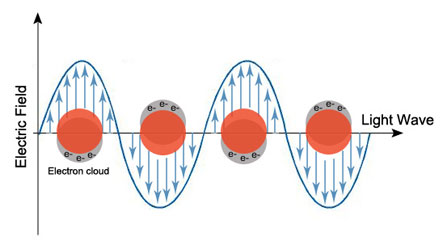Localized Surface Plasmon Resonance: Harnessing Light at the Nanoscale
What is Localized Surface Plasmon Resonance?
Localized surface plasmon resonance (LSPR) is a phenomenon that occurs when light interacts with conductive nanoparticles that are smaller than the incident wavelength. It involves the collective oscillation of free electrons in the nanoparticle, leading to strong light absorption, scattering, and enhancement of the local electromagnetic field. LSPR is highly sensitive to the nanoparticle's size, shape, composition, and local dielectric environment, making it a powerful tool for various applications in nanophotonics, sensing, and catalysis.

Differences between LSPR and Surface Plasmon Resonance
While both LSPR and surface plasmon resonance (SPR) involve the resonant oscillation of surface plasmons, they have distinct differences:
- Geometry: LSPR occurs in nanoscale structures such as nanoparticles, nanorods, or nanoshells, while SPR typically occurs in thin metal films or planar metal-dielectric interfaces.
- Excitation: LSPR can be excited by direct light illumination, as the oscillations are confined within the nanostructure. In contrast, SPR requires a special configuration, such as the Kretschmann or Otto configuration, to match the momentum of the incident light with the surface plasmons.
- Sensitivity: LSPR is highly sensitive to changes in the local dielectric environment near the nanostructure surface, while SPR is sensitive to changes in the refractive index of the medium close to the metal surface.
- Field Enhancement: LSPR can lead to strong localized electromagnetic field enhancements near the nanostructure surface, whereas SPR results in less localized field enhancement compared to LSPR.
Factors Influencing LSPR
Several factors influence the LSPR properties of metal nanoparticles:
- Size and Shape: The size and shape of the nanoparticle significantly affect the LSPR wavelength and intensity. Larger nanoparticles exhibit red-shifted LSPR peaks, while anisotropic shapes such as nanorods and nanostars can support multiple LSPR modes.
- Composition: The material composition of the nanoparticle determines its optical properties. Noble metals like gold and silver are commonly used due to their strong LSPR in the visible and near-infrared regions. Other materials, such as aluminum and copper, have also been explored for LSPR applications.
- Dielectric Environment: The surrounding dielectric environment influences the LSPR wavelength and sensitivity. Changes in the refractive index near the nanoparticle surface lead to shifts in the LSPR peak position, which forms the basis for LSPR-based sensing applications.
- Interparticle Coupling: When nanoparticles are in close proximity, their LSPR modes can couple, resulting in enhanced electric fields and shifts in the LSPR wavelength. This coupling effect is exploited in applications such as surface-enhanced Raman scattering (SERS) and plasmon-enhanced fluorescence.
Applications of LSPR
LSPR has found numerous applications across various fields:
Biosensing and Chemical Sensing
LSPR-based sensors have emerged as powerful tools for label-free detection of biomolecules and chemical analytes. The high sensitivity of LSPR to changes in the local dielectric environment enables the detection of minute concentrations of target molecules. LSPR sensors have been developed for the detection of proteins, DNA, viruses, and small molecules, with applications in healthcare, environmental monitoring, and food safety.
Surface-Enhanced Raman Scattering (SERS)
LSPR plays a crucial role in Surface-Enhanced Raman Scattering, a technique that enhances the Raman scattering signals of molecules adsorbed on metal nanostructures. The strong localized electromagnetic fields generated by LSPR can dramatically increase the Raman scattering intensity, enabling single-molecule detection and highly sensitive chemical analysis. SERS has found applications in chemical and biological sensing, forensic analysis, and materials characterization.
Photocatalysis and Solar Energy Conversion
LSPR can be harnessed to enhance photocatalytic reactions and solar energy conversion. Metal nanoparticles supporting LSPR can act as efficient light absorbers and charge carriers, promoting electron transfer and catalytic processes. LSPR-driven photocatalysis has been employed for water splitting, CO2 reduction, and the degradation of organic pollutants. In solar cells, LSPR can be utilized to improve light absorption and enhance the efficiency of energy conversion.
Future Perspectives and Challenges
The field of LSPR continues to evolve, with ongoing research focused on developing advanced nanostructures, exploring new materials, and expanding the range of applications. Future directions include the integration of LSPR with other nanomaterials, such as 2D materials and quantum dots, to create hybrid systems with enhanced functionality. The development of large-scale, cost-effective fabrication methods for LSPR nanostructures is also a key challenge to be addressed for widespread practical implementation.
Additionally, fundamental understanding of the LSPR mechanisms, particularly in complex nanostructures and coupled systems, remains an active area of investigation. Advanced computational methods and in situ characterization techniques are being developed to provide deeper insights into the LSPR phenomena and guide the rational design of LSPR-based devices.
Further Reading
Annual Review of Physical Chemistry, Localized Surface Plasmon Resonance Spectroscopy and Sensing
Chemical Society Reviews, Localized surface plasmon resonance for enhanced electrocatalysis
